Moving out
The timing of bass moving to main-lake drops may surprise you
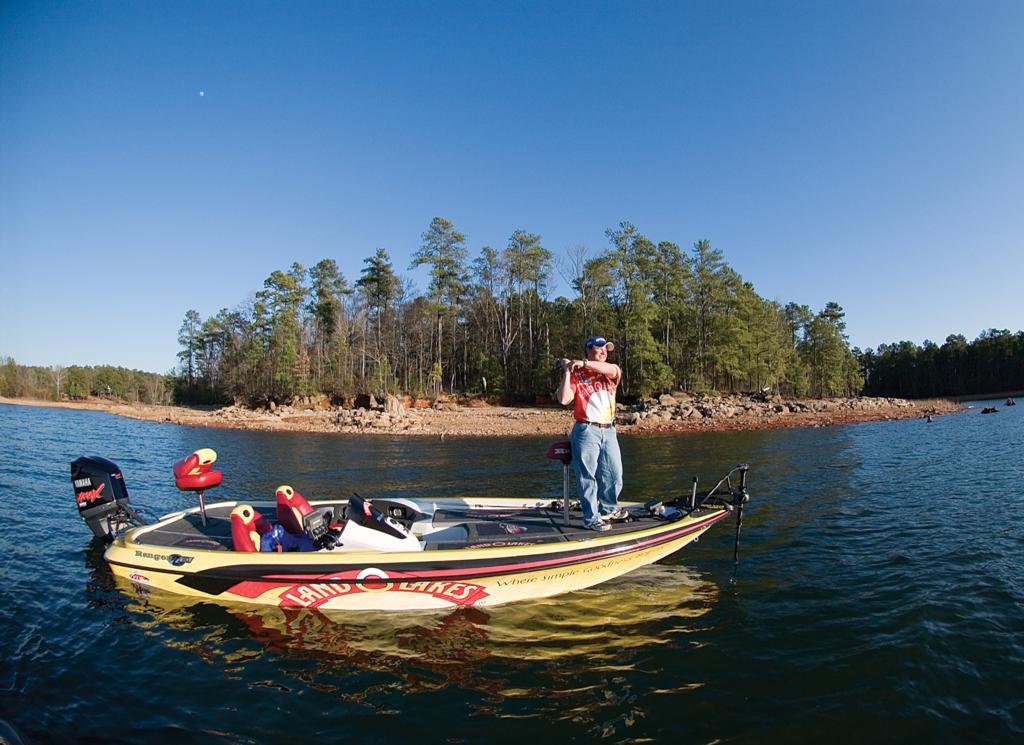
————————————–
Editor’s note: This article originally appeared in the April 2006 issue of FLW Outdoors Magazine. Learn more about FLW Outdoors Magazine and how to subscribe by clicking here.
————————————–
No matter where you live, largemouth bass follow a consistent pattern every spring. They move up from deep water into shallow water to spawn. After spawning, they leave their shallow nesting areas and move back to deep water, where they orient to topographic structure such as ledges, points and channels.
This, however, isn’t a one-time event. A single female bass will service several nests during her spawning cycle, moving shallow and back deep again several times before completing her reproductive duties. On large lakes, the spawn may occur at one end as much as two weeks earlier than at the far end.
Once the males have satisfied their domestic obligations and packed the little ones off to “school,” they follow the females to their deep haunts.
By understanding the timing of this pattern on your home water, you can adjust your tactics to catch fish offshore on any body of water anywhere in the country.
Mike Armstrong, chief of fisheries for the Arkansas Game and Fish Commission, said contrary to popular belief, there is no mass movement of bass from spawning areas to deep structure. These movements occur over a period lasting two to four weeks, depending on weather. The most important variable, he added, is water temperature.
“Water temperature triggers the majority of bass behavior,” Armstrong said. “Photoperiod is secondary, and scientifically, we’re not sure which one plays the larger role. Photoperiod sets the time frame for things to happen, but water temperature is more important for activity for short periods.”
That explains why you might see bass on the beds for several days on a certain lake, and then suddenly the banks are devoid of fish after a cold front.
“In the spring, we routinely see bass that were building nests one week move back down in deeper water when a cold front moves through,” Armstrong said.
That could also happen because a sow bass finished seeding one nest and moved on to seed another.
“Female bass don’t release all their eggs in one nest,” Armstrong explained. “They’ll visit a number of nests. This reproductive strategy helps assure that some of those nests will produce young. Some of those nests get caught in a cold front. When the water temperature drops, the eggs will get a fungus, and the males will abandon them. That’s not unusual. We call it cold-water fungus.”
Since Arkansas is generally in the center of the country, its lakes are subject to both northern and southern weather patterns. On Northern Arkansas lakes, such as Beaver, Bull Shoals and Norfork, the spawn is slightly ahead of Lake of the Ozarks and Truman Reservoir in Missouri, as well as at Kentucky and Barkley lakes. However, it’s also slightly behind lakes along the latitudes of those in 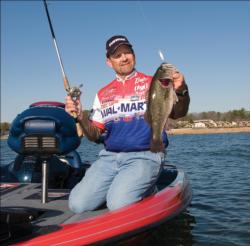 Northern Louisiana and Mississippi. Therefore, spawning conditions in Arkansas can serve as a rough average for regional conditions and can provide a reliable indicator for timing the migration to deep water anywhere in the country.
Northern Louisiana and Mississippi. Therefore, spawning conditions in Arkansas can serve as a rough average for regional conditions and can provide a reliable indicator for timing the migration to deep water anywhere in the country.
Walmart pro George Cochran of Hot Springs, Ark., winner of the 2005 Walmart FLW Tour Championship, starts seeing spawning fish in Arkansas in April and stops seeing them in May.
“In May, bass start moving to points and dropoffs on the main lake and to creek channels off the main lake,” Cochran said. “The first thing they’ll do when they move out is give you real good topwater fishing on long, tapering points and on ridges. They’ll move onto structure at first in May and June, but they’re not real deep yet.
“By July, the thermocline starts getting deeper, and the bass go deeper with it. From May until the first of June, you can catch them on topwaters and cranking. By July, you have to catch them on Carolina rigs, drop-shots and deep cranking.”
On natural lakes, such as those in Florida, there isn’t much deep water or noticeable offshore structure. Consequently, bass move horizontally, from the bank to the outside edges of deep weedbeds and back again. This might occur throughout the winter and all the way through the spawn.
“As soon as that water gets up in the 60s, bass will start moving up shallow,” Cochran said. “In January, the weather gets warm for a week or so, they’ll start moving up; as soon as a cold front moves through and the water temperature drops 5 or 6 degrees, they’ll move back to the outside edges again.”
When bass position over deep structure, Cochran reaches for them with a crankbait that will dive between 10 and 15 feet. His choices include a Strike King Series 5 or 6, or a Norman Deep Little N.
“You want it to go down to bump the bottom,” Cochran said. “I position my boat right on the dropoff, like paralleling a highway, and make a long cast where it starts in about 10 feet of water. I want it to start 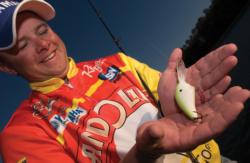 bumping. When it comes to a ledge, it bumps the ledge and then falls off into the channel. That’s where the fish usually are, suspended or on the bottom.”
bumping. When it comes to a ledge, it bumps the ledge and then falls off into the channel. That’s where the fish usually are, suspended or on the bottom.”
Land O’Lakes pro Jeremiah Kindy of Benton, Ark., also competed in the 2005 FLW Tour Championship. Postspawn fishing is one of his strong suits, and he relies on a set of conditions to tell him when to start mining deep structure.
“I want the water temperature to be in the upper 60s, preferably in the 70s, to start `drop’ fishing,” Kindy said, “but I have caught them on dropoffs when it was in the low 60s.”
To learn the conditions on the lake or river he’ll be fishing, Kindy goes to the Internet for current weather and fishing information.
“A lot of what you read isn’t true,” Kindy said, “but you learn to decipher what’s accurate and what isn’t. Tournament results and weather reports are usually pretty reliable, so I look at the water temperatures they’ve had in the last month and base that on where the fish ought to be.
“Once I put my boat in the water, I may not make a cast for four hours,” he added. “I’ll run to different creek arms and bays and look for the warmest water I can find to decide if I want to `drop’ fish.”
In addition to water temperature, Kindy pays attention to photoperiod, and especially close attention to moon phase. He says those factors also influence when fish are likely to be on deep structure during and after the spawning period.
“Bass like to spawn on the full moon and the new moon,” Kindy said. “If you’re going to a tournament in 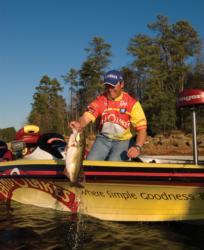 April and there’s already been a full moon and new moon, you know they’re going to be on the drops. A lot of times, of course, you don’t have a choice of when you can go, but the temperature gauge and moon phases have everything to do with when you should be `drop’ fishing.”
April and there’s already been a full moon and new moon, you know they’re going to be on the drops. A lot of times, of course, you don’t have a choice of when you can go, but the temperature gauge and moon phases have everything to do with when you should be `drop’ fishing.”
When he finds bass on deep structure, Kindy also goes after them with deep-diving crankbaits, as well as with plastic worms on Texas or Carolina rigs.
“I want something that will get to the bottom,” Kindy said. “They’re in major schools that time of year, so I’ll probably throw a Norman DD22 until I find a school, and then I’ll slow down. I’m liable to sit in the same spot all day long. A lot of people think that when fish come off the beds, you can’t catch them, but that’s not true. That’s when I do some of my favorite fishing, but a lot of people don’t understand how to catch those bass.”
By keeping abreast of regional weather conditions, Kindy and Cochran can predict whether bass will be on deep drops based on the progression of the spawn in other areas.
“In late April, if I’m going to go to the Potomac River, bass are liable to still be spawning up there because of differences in climate,” Kindy said. “In Lake Champlain, they’re liable to be spawning in June. It all depends on the climate.”
And climate basically boils down to that magic range in water temperature. When it hits that magic window, it’s time to hit the “drops.”
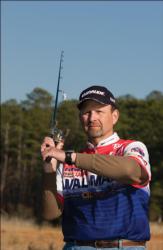 Reels for deep cranking: horsepower vs. speed
Reels for deep cranking: horsepower vs. speed
When using deep-diving crankbaits to catch bass on deep structure, there are competing schools of thought. Some anglers prefer to use slow-speed reels with low gear ratios in the neighborhood of 4.1:1. These reels are great for moving crankbaits slowly through a strike zone, and their high torque is great for coaxing the maximum amount of vibration from big, wide-bodied crankbaits like a Bagley’s DB2.
Others, like George Cochran and Jeremiah Kindy, prefer fast reels.
“I like a reel with a 6:1 ratio,” Cochran said. “I’m just opposite from people who like reels in the 4:1 or 3.7:1 range. I like a reel that’s got a high gear ratio so I don’t have to crank it very much. I’ll be doing it all day, and once I get it down, I can slow it down. If I get a fish on, I rarely lose them because I don’t get slack in my line.”
Likewise, Kindy likes fast reels because they tweak the best performance from the crankbaits he uses.
“I like a crankbait with a nice, tight wobble, and I like to `burn’ it,” Kindy said. “Because of that tight wobble, it will still run true, compared to a Wiggle Wart, which I also like, but it’s got a wide wobble, and you can’t `burn’ it because it will turn up on its side.”
For that reason, a Wiggle Wart and similar lures perform better with slower, higher-torque reels. By matching your reels and lures to specific applications, you can get maximum performance from both.